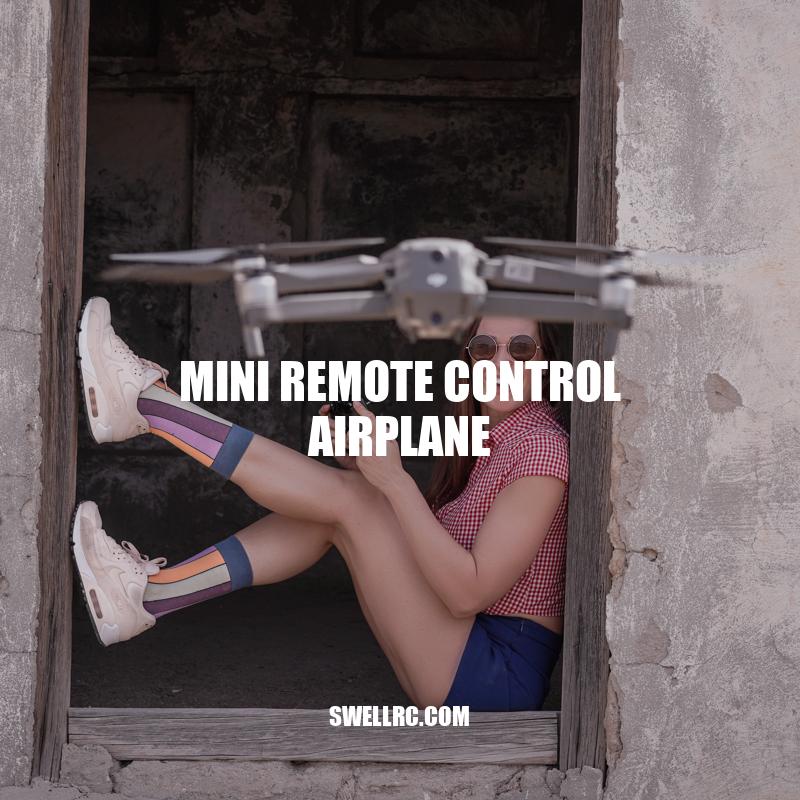Mini Remote Control Airplanes: Your Ultimate Guide
Mini remote control airplanes have become increasingly popular among hobbyists in recent years. These miniature aircraft offer the thrill and excitement of flying, without the risk or cost associated with piloting full-size planes. With advances in technology, mini remote control airplanes have become smaller, more agile, and more functional, with features such as live streaming, GPS tracking, and advanced control systems. Choosing the right mini remote control airplane can be overwhelming, as there are several different types and models to choose from. Factors to consider may include experience level, the type of flying you plan to do, and the budget you have available. Once you have chosen your mini remote control airplane, the fun begins! However, before you take off, it’s important to have some basic knowledge of flying techniques, safety tips, and maintenance practices to ensure a smooth and enjoyable flying experience. In this article, we will explore everything you need to know about mini remote control airplanes, from choosing the right model to maintaining it for maximum longevity.
Mini remote control airplanes come in several types, so it’s important to choose the right one for your needs. When selecting a mini remote control airplane, consider the environment you will be flying it in, your experience level, and your budget. There are several types of mini remote control airplanes available, including indoor mini remote control airplanes and outdoor mini remote control airplanes.
Indoor mini remote control airplanes are lighter and smaller, making them suitable for flying indoors in small rooms or even hallways without causing any damage to furniture or walls. Outdoor mini remote control airplanes, on the other hand, are built for speed and range. They are perfect for more advanced pilots who prefer the added challenge of flying in open spaces.
Fixed-wing airplanes are the most common type of mini remote control airplanes. They have a solid wing and are powered by either an electric motor or a gas engine. Mini remote control helicopters, on the other hand, are popular for their unique flying experience, with the ability to hover and fly in all directions. They are more challenging to fly than fixed-wing airplanes but can be more rewarding. For those interested in aerial photography or videography, mini remote control quadcopters are equipped with a camera and can fly in all directions.
For those unsure of which type of mini remote control airplane to choose, there are plenty of resources online or in-person for help. Websites such as HobbyKing and Horizon Hobby offer a wide range of mini remote control airplanes and related products.
What is small remote controlled aircraft known as?
Small remote controlled aircraft are known as drones or quadcopters. These devices are controlled by a remote and typically have a camera attached to them. They have gained popularity in recent years for their recreational use and for commercial purposes such as aerial photography and videography.
If you’re interested in purchasing a drone or learning more about them, there are many websites that offer product reviews and buying guides. Some popular drone retailers include:
- DJI
- Amazon
- Best Buy
- DroneNerds
Additionally, the Federal Aviation Administration (FAA) has regulations and guidelines for drone usage in the United States. For more information, visit their website.
Choosing the Right Mini Remote Control Airplanes
Choosing the right mini remote control airplane is crucial for an enjoyable and successful flying experience. When making a decision, consider the following factors:
– Level of experience: If you are a beginner, look for an airplane that is easy to fly. For more experienced pilots, consider a more advanced airplane that offers greater maneuverability.
– Model: There are many different models of mini remote control airplanes to choose from, so it’s important to find one that fits your preferences.
– Size: The size of the airplane will affect its maneuverability and flight time. Small airplanes are easier to fly indoors, while larger ones are better suited for outdoor environments.
– Range: Consider the range of the airplane to ensure that you can fly it in the area you have available. For indoor use, a range of around 100 feet is usually sufficient, while outdoor airplanes need a longer range.
– Price: Mini remote control airplanes are available at different price points depending on their features, so set a budget that works for you.
When shopping for a mini remote control airplane, you can find a wide selection on websites like Amazon and eBay. In addition, some companies like Blade and E-flite offer mini remote control airplanes with advanced features like GPS navigation and smartphone connectivity.
If you are new to the world of mini remote control airplanes, consider investing in a flight simulator like RealFlight. This product allows you to practice flying different types of airplanes without risking damage to your actual airplane.
The following table provides a comparison of some popular mini remote control airplanes:
| Model | Type | Power source | Range | Price |
|---|---|---|---|---|
| Blade Nano QX | Quadcopter | Electric | 150 feet | $100 |
| E-flite UMX Radian | Fixed-wing airplane | Electric | 300 feet | $120 |
| Volantex RC Ranger | Outdoor airplane | Electric | 500 feet | $150 |
What is a good remote control plane?
A good remote control plane is determined by various factors such as design, build quality, flight stability, and ease of control. If you are a beginner, it’s best to start with a basic model that has simple controls and is easy to fly.
Here are some features to consider when looking for a good remote control plane:
| Feature | Description |
|---|---|
| Wingspan | Choose a size that matches your skill level and flying conditions. Smaller wingspans are easier to control but can’t handle high winds. |
| Power source | Gas, electric or battery-powered planes. Electric planes are easier to operate and are generally better for beginners, while gas models are better for experienced pilots. |
| Construction | Look for planes made with lightweight and durable materials like foam or carbon fiber. |
| Flight time | Choose a plane with a flight time that suits your needs. |
| Camera mount | Consider whether you want to attach a camera to the plane for aerial photography or videography. |
Some good remote control planes to consider include the Hobbypark RC Airplane, the E-flite Apprentice S 15e RTF, and the Flyzone Remote Control Airplane. Check out websites like Amazon and Hobby King for more options and reviews from other buyers.
Flying Techniques and Safety Tips for Mini Remote Control Airplanes
Flying mini remote control airplanes requires some basic techniques and safety measures to avoid accidents and damage.
Here are some tips to ensure a safe and successful flying experience:
– Find a clear and open area: Ensure the area where you plan to fly your airplane is free of obstructions and people. Keep in mind that indoor airplanes should be flown in a room with a high ceiling to avoid collisions with the ceiling.
– Check the weather conditions: Flying outdoors during stormy or windy conditions can be dangerous and can result in damage or loss of your airplane.
– Take off and landing: Use the throttle control to slowly increase the power of the airplane and release it at the right moment to take off. To land your airplane, reduce the speed when nearing the ground and use the throttle control to slow down gradually.
– Control the altitude and direction: Use the elevator and rudder controls respectively to change the altitude and direction of your airplane.
– Reduce speed when approaching: When your airplane is close to the landing spot, reduce the speed to avoid damaging it.
– Follow the rules: Observe the rules and regulations related to flying mini remote control airplanes in your area. Avoid flying near airports and other restricted areas.
When it comes to safety gear, consider using:
– Safety goggles: These will protect your eyes from dust and debris while flying.
– Gloves: Gloves can improve your grip on the remote control and prevent hand injuries while handling your airplane.
– Propeller guards: Propeller guards can protect the propellers from damage during a crash.
In addition, there are many online resources such as RCgroups.com, RC Universe, and RC Heli Talk forums that offer guidance and support for those interested in flying mini remote control airplanes. It’s always a good idea to watch tutorials on YouTube or seek advice from experienced pilots to improve your skills.
How do you fly a remote control airplane?
To fly a remote control airplane, follow these steps:
- Make sure you have a clear and open area to fly.
- Power on the remote control and airplane.
- Gradually push the throttle up to take off.
- Use the remote control to adjust the direction of the airplane.
- Practice flying in straight lines before attempting any advanced maneuvers.
- When landing, slowly bring down the throttle and gently guide the airplane to the ground.
For more information on remote control airplanes and flying tips, check out websites such as rcuniverse.com or hobbyzone.com. Additionally, products such as the DXe Transmitter by Spektrum and the Apprentice S 15e airplane by E-flite provide user-friendly options for beginners.
Maintenance and Upkeep
Taking care of your mini remote control airplane is essential for its proper functioning and longevity. Here are some maintenance and upkeep tips to keep your airplane in good condition:
– Clean your airplane after use: Always clean your airplane after use to remove dirt, debris, and other particles that may affect its performance. You can use a soft brush or compressed air to clean the airplane.
– Check for damage: Regularly inspect your airplane for any damage or wear and tear. Look for cracks in the body, damage to the wing, propeller, or landing gear. Replace any damaged parts as soon as possible.
– Charge the batteries correctly: Charge the batteries of your airplane according to the instructions provided by the manufacturer. Do not overcharge the batteries, as this can lead to damage or reduced battery life.
– Store properly: Store your airplane in a cool and dry place when not in use. Keep the batteries charged and remove them if you’re not planning to use the airplane for a long time.
– Troubleshooting: If your airplane is not performing as expected, try troubleshooting common problems such as battery issues, communication or signal problems, and engine problems. Seek advice from online resources, forums or support from the manufacturer.
There are also some products you may need for proper maintenance, such as:
– Replacement parts: Replacement parts such as propellers, batteries, chargers, and landing gear, among others, are essential for the proper upkeep of your airplane.
– Cleaning products: You may need specialized products such as compressed air, soft brushes, or cleaning sprays for cleaning your airplane.
– Toolkits: Toolkits that include screwdrivers, pliers, and other tools are necessary for repairing or replacing damaged parts.
In some cases, it may be more efficient to take your airplane to a professional for maintenance or repair. There are specialized shops and workshops where you can take your airplane and get it repaired or upgraded by trained professionals.
How do you take care of an airplane?
Taking care of an airplane involves regular maintenance and inspections to ensure its safety and efficiency. Here are some basic steps for airplane maintenance:
- Perform daily inspections before and after flights.
- Wash and clean the exterior and interior regularly.
- Check the oil and fluid levels, and change them as needed.
- Replace worn-out or damaged parts immediately.
- Keep the plane hangared or covered to protect it from weather elements.
It’s important to follow the manufacturer’s guidelines and the regulations of the aviation authority in your region. You can also consult with aviation maintenance professionals or check out websites such as aviationpros.com or FAA.gov for more information on airplane maintenance and care products.
Conclusion
In conclusion, mini remote control airplanes offer a great hobby experience for people of all ages and skill levels. With advancements in technology, mini remote control airplanes are becoming more accessible and affordable. However, it is essential to choose the right model, follow safety rules, and maintain the airplane properly to get the best performance and longevity out of it.
Whether you enjoy flying indoors or outdoors, there is a mini remote control airplane that can suit your needs. With a wide range of models available on the market, you can choose the one that fits your budget and skill level. With regular maintenance and upkeep, you can keep your airplane in good condition and extend its lifespan.
If you’re interested in this hobby and want to learn more, there are several online resources and communities available, such as forums and YouTube channels, where you can find tips, tricks, and advice from experienced hobbyists. Additionally, some manufacturers offer instructional videos and manuals to assist you in setting up and operating your airplane.
Overall, mini remote control airplanes are a fun and exciting hobby that can provide a unique experience while also developing hand-eye coordination and concentration skills. Be sure to explore all your options and take safety and maintenance seriously to ensure an enjoyable and long-lasting experience.



